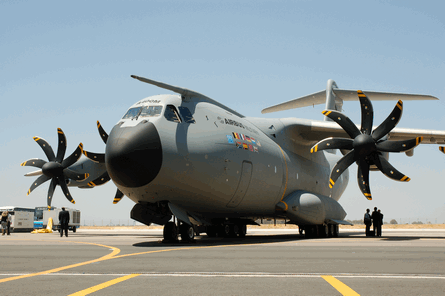By Siva Govindasamy, Craig Hoyle & Stephen Trimble
The inauguration of a new US president seldom heralds immediate changes for the nation's military acquisition programmes, but that tradition is likely to be undone this year.
President-elect Barack Obama's national security team will instantly face decisions on either prolonging or dismantling production lines for the US Air Force's Boeing C-17 strategic transport and Lockheed Martin F-22 air superiority fighter, and on whether and how to initiate contracts to replace some of its current in-flight refuelling tankers and combat search-and-rescue helicopters.
Separately, Lockheed's F-35 Joint Strike Fighter and the EADS-led Airbus Military A400M face potential make or break flight-test milestones, and industrial partners in the Eurofighter project will pressure their European customers to honour a shared commitment to Tranche 3 production of the type.
The global economic downturn will heap additional pressure on those nations already struggling to balance the need to fund current operational commitments and meet their armed forces' long-term equipment requirements. Other countries merely attempting to replace obsolete aircraft through new procurements will also suffer. Asian nations are expected to be especially hard hit in the latter category, while some analysts believe that after 11 years of continuous growth, US defence spending could peak this year.
BREAKTHROUGH TECHNOLOGIES
Fresh selections in the USAF's KC-X tanker and CSAR-X helicopter contests were postponed last year by President George Bush's staff, but Secretary of Defense Bob Gates reinherits the decisions after being retained as the Department of Defense's civilian leader under the Obama administration.
 |
|---|
© Lockheed Martin |
Several potential breakthrough technologies are to undergo pivotal testing for the US armed forces this year, with Lockheed's first short take-off and vertical landing JSF prototype scheduled to resume flight activities in the first quarter after a hiatus to correct a blade fatigue problem in its Pratt & Whitney F135 engine. Named BF-1, the aircraft will in June perform its first transition from horizontal flight to vertical landing: possibly a key event in keeping the current JSF partners in the programme, and attracting interest from potential additional buyers.
CLEAN SWEEP
Positive decisions by the Dutch and Norwegian governments in late 2008 should bode well for the JSF, and Lockheed hopes to soon complete a European clean sweep, with Denmark due to decide between the F-35, Boeing's F/A-18E/F Super Hornet and Saab's rival Gripen NG as a Lockheed F-16 replacement. The Netherlands and the UK should also next month commit to buying their first F-35s to participate in initial operational test and evaluation activities.
A Lockheed high-altitude airship is set for a first flight in June. One US Senator last month derided the concept as one of the government's most excessive wastes of taxpayer money, but it is clear that interest runs high among the Pentagon's civilian leadership. Airships are being developed to detect a range of ballistic and cruise missile threats, but could also perform surveillance and communications tasks.
Later in the year, the US Missile Defense Agency will discover whether a $5 billion investment in Boeing's 747-based Airborne Laser has produced a system capable of shooting down a ballistic missile, at least under demonstration conditions, with a first in-flight intercept test scheduled for late August or early September. Separately, Boeing's Airborne Tactical Laser design will begin a three-year user demonstration with special operations forces using a modified Lockheed C-130 transport.
The first of two Northrop Grumman X-47Bs should make its flight debut in the fourth quarter under the US Navy's unmanned combat air system-demonstration programme, which aims to prove the viability of carrier-based operations of an unmanned combat air vehicle. Success could have a revolutionary impact on the future of military aircraft technology and acquisition.
In Europe, the Eurofighter consortium needs an agreement on Tranche 3 production in the early part of the year if it is to achieve its planned manufacture of 620 aircraft for Germany, Italy, Spain and the UK, although a third export success appears imminent, with the UK government brokering a Typhoon sale to Oman. The fighter also figures in a three-way contest with the Gripen and Dassault's Rafale in Switzerland, with a selection expected in mid-July. Brazil should also choose this year between the Gripen NG, Rafale and Super Hornet.
A400M CONFIDENCE
Airbus Military's troubled A400M transport will remain in the media spotlight, with the programme's industrial partners, propulsion system suppliers and military customers hoping for better than the repeat crises that beset EADS's production and flight-test plans in 2008. Successful flight tests from mid-2009 will be needed to restore confidence in the project, and to revive its fading hopes of securing additional export sales, which may grow fainter if Boeing succeeds in securing a stay of execution for the C-17.
 |
|---|
© Airbus Military |
Asia's highest-profile fighter battles could see India narrow the field in its medium multirole combat aircraft contest, and Japan revive its delayed F-X competition if forced to abandon hope of gaining export approval for the at-risk F-22. Tokyo could also for the first time look to the JSF for its future requirements, with regional interest also expected to increase from Singapore and South Korea. Australia's near-term release of a new defence White Paper will shed some light on its long-term procurement strategies, including for the F-35.
SINGAPORE CHOICE
Singapore could meanwhile decide between Alenia Aermacchi's M-346 and the Korea Aerospace Industries/Lockheed T-50 in its advanced jet trainer contest, perhaps pointing the way to a new sector champion.
For rotorcraft, India and South Korea could make progress in their long-held plans to acquire new attack helicopters, with Seoul to decide whether to expand a domestic utility helicopter programme or launch a separate tender.
Combat operations involving the USA and allied nations will be dominated by heightened activity in battling the Taliban in Afghanistan, with an expected drawdown of ground troops in Iraq to free scarce assets such as helicopters, fighters, unmanned air vehicles and intelligence, surveillance and reconnaissance aircraft.
Source: Flight International



















